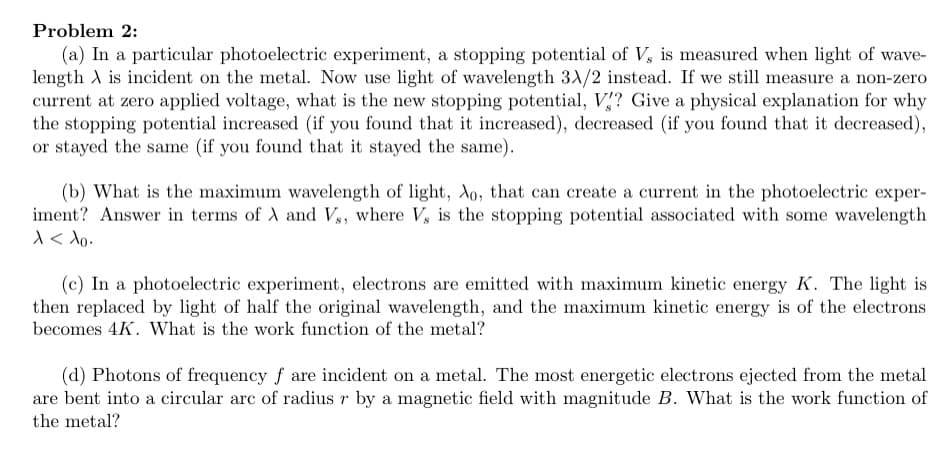(a) In a particular photoelectric experiment, a stopping potential of V, is measured when light of wave- length A is incident on the metal. Now use light of wavelength 3A/2 instead. If we still measure a non-zero current at zero applied voltage, what is the new stopping potential, V? Give a physical explanation for why the stopping potential increased (if you found that it increased), decreased (if you found that it decreased), or stayed the same (if you found that it stayed the same). (b) What is the maximum wavelength of light, do, that can create a current in the photoelectric exper- iment? Answer in terms of A and V,, where V, is the stopping potential associated with some wavelength 1< do. (c) In a photoelectric experiment, electrons are emitted with maximum kinetic energy K. The light is then replaced by light of half the original wavelength, and the maximum kinetic energy is of the electrons becomes 4K. What is the work function of the metal?
(a) In a particular photoelectric experiment, a stopping potential of V, is measured when light of wave- length A is incident on the metal. Now use light of wavelength 3A/2 instead. If we still measure a non-zero current at zero applied voltage, what is the new stopping potential, V? Give a physical explanation for why the stopping potential increased (if you found that it increased), decreased (if you found that it decreased), or stayed the same (if you found that it stayed the same). (b) What is the maximum wavelength of light, do, that can create a current in the photoelectric exper- iment? Answer in terms of A and V,, where V, is the stopping potential associated with some wavelength 1< do. (c) In a photoelectric experiment, electrons are emitted with maximum kinetic energy K. The light is then replaced by light of half the original wavelength, and the maximum kinetic energy is of the electrons becomes 4K. What is the work function of the metal?
Principles of Physics: A Calculus-Based Text
5th Edition
ISBN:9781133104261
Author:Raymond A. Serway, John W. Jewett
Publisher:Raymond A. Serway, John W. Jewett
Chapter28: Quantum Physics
Section: Chapter Questions
Problem 30P
Related questions
Question

Transcribed Image Text:Problem 2:
(a) In a particular photoelectric experiment, a stopping potential of V, is measured when light of wave-
length A is incident on the metal. Now use light of wavelength 3A/2 instead. If we still measure a non-zero
current at zero applied voltage, what is the new stopping potential, V? Give a physical explanation for why
the stopping potential increased (if you found that it increased), decreased (if you found that it decreased),
or stayed the same (if you found that it stayed the same).
(b) What is the maximum wavelength of light, do, that can create a current in the photoelectric exper-
iment? Answer in terms of A and V,, where V, is the stopping potential associated with some wavelength
1< Ao.
(c) In a photoelectric experiment, electrons are emitted with maximum kinetic energy K. The light is
then replaced by light of half the original wavelength, and the maximum kinetic energy is of the electrons
becomes 4K. What is the work function of the metal?
(d) Photons of frequency f are incident on a metal. The most energetic electrons ejected from the metal
are bent into a circular arc of radius r by a magnetic field with magnitude B. What is the work function of
the metal?
Expert Solution
This question has been solved!
Explore an expertly crafted, step-by-step solution for a thorough understanding of key concepts.
This is a popular solution!
Trending now
This is a popular solution!
Step by step
Solved in 4 steps

Knowledge Booster
Learn more about
Need a deep-dive on the concept behind this application? Look no further. Learn more about this topic, physics and related others by exploring similar questions and additional content below.Recommended textbooks for you

Principles of Physics: A Calculus-Based Text
Physics
ISBN:
9781133104261
Author:
Raymond A. Serway, John W. Jewett
Publisher:
Cengage Learning

Physics for Scientists and Engineers with Modern …
Physics
ISBN:
9781337553292
Author:
Raymond A. Serway, John W. Jewett
Publisher:
Cengage Learning

Modern Physics
Physics
ISBN:
9781111794378
Author:
Raymond A. Serway, Clement J. Moses, Curt A. Moyer
Publisher:
Cengage Learning

Principles of Physics: A Calculus-Based Text
Physics
ISBN:
9781133104261
Author:
Raymond A. Serway, John W. Jewett
Publisher:
Cengage Learning

Physics for Scientists and Engineers with Modern …
Physics
ISBN:
9781337553292
Author:
Raymond A. Serway, John W. Jewett
Publisher:
Cengage Learning

Modern Physics
Physics
ISBN:
9781111794378
Author:
Raymond A. Serway, Clement J. Moses, Curt A. Moyer
Publisher:
Cengage Learning

University Physics Volume 3
Physics
ISBN:
9781938168185
Author:
William Moebs, Jeff Sanny
Publisher:
OpenStax